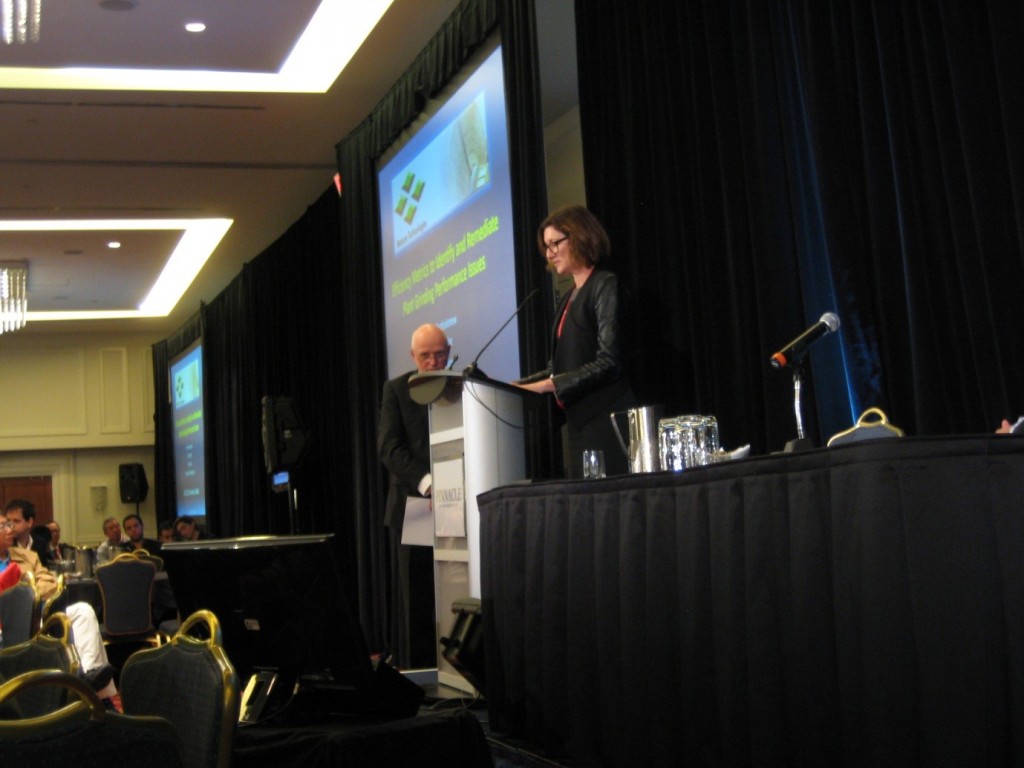Well here we are back in Vancouver for another SAG conference marathon, 4 days of back to back presentations starting at 8pm and finishing some 12 hours later. A real marathon especially for those of us battling jetlag… as I bash away at the keyboard, 4am local time.
This morning SAG2015 got off to an awesome start with about 600 delegates attendance. Bern Klein welcomed us and outlined this year was going to be different, with an exhibition, poster sessions and a focus on the comminution value chain including geometallurgy and ore sorting. Who said SAG was just about the humble tumbling mill?.. Did anyone notice the new curtains and lights?.. LEDs I’m sure, it’s all about doing more with less at these metal prices.
The first technical session was about benchmarking and was co-chaired by CEEC’s own Sarah Boucaut. Sarah did an excellent job introducing the speakers for the morning session and even managed a CEEC plug. Well done Sarah.
The first session showed that a number of organisations are tackling benchmarking. Grant Ballantyne presented CEEC Energy Curve findings. This was complemented by data benchmarking activities at UBC where single particle breakage energy is used as a basis for comparison, at Metso where heat losses from the mill were investigated, and Metcom introduced a metric based on classification. General theme being – if you can’t measure it, you can’t improve it.
Morning tea was served, and we were straight into a presentation from industry heavy – Steve Morrell. So how big is your database? Apparently 36000 is a good number. Morrell showed that from the SMC test database he deduced that basalt and tungsten are very hard, that SG tracks ore hardness – nice one.
An impressive paper by Marcus Bueno tied geometallurgy to comminution circuit design. It promoted us to move away from single point design (information provided in a process design criteria) for equipment sizing and selection, rather embrace a more holistic view of the orebody from the geo block model. Identify the ore types, do characterisation work on these rather than a composite and base performance predictions on the mine schedule. Makes sense to me.
More coffee and cake and we’re talking pre-concentration. Notions of selective comminution (staged breakage and separation at small sizes) and grade engineering were presented. Where natural grade deportment is exploited for separation and waste rejection opportunities, necessitating a more complex yet sassy grinding circuit.. But the big question remains, how much will this cost to build and operate?.
An interesting paper by Anglo American Plat followed, showing an XRF ore sorter installed to reject low grade PGMs. Apparently the upgrade possible with this device can put many operations back in the black. Installed at Anglo Plat are 4 sorting machines to achieve 30ktpm (single particle presentation), rejecting 40% of the ore. Apparently the Russians have been onto this for a while and have 200 of these units installed at 51 sites.
The session was wrapped with a summary from MineSense, a bulk sorting approach – good for high tonnages and the exciting option of high voltage breakage for particle pre-weakening and pre-concentration.
The afternoon featured ore characterisation tests for SAG mills and HPGRS. Sebastian Tello told us about a new SGSE (SAG Circuit Specific Energy) from the JK to be rolled out with all Axb results – to help us with ore blending as the relation is linear. Mark Shearman argued that the bond method can be tweaked to size SAG mills and that media size impacts wear, this was provocative to some.
Another highlight was large scale pilot test of a HPGR on Morenci ore. The work showed that a truncated feed produced more fines, that throughput did not increase with rolls speed and that flange roll closing decreased both the SE and re-circulating load, SE by 13% and increased throughput by 19%. Good work.
Look forwarding forward to day 2 – and shaking this jetlag.
Zeljka Pokrajcic

